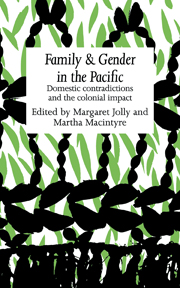Book contents
- Frontmatter
- Contents
- List of contributors
- Acknowledgements
- Map of main island groups of the Pacific
- Map of Papua New Guinea – Provinces
- Introduction
- 1 New England missionary wives, Hawaiian women and ‘The Cult of True Womanhood’
- 2 Changes in the lives of ordinary women in early post-contact Hawaii
- 3 Domestic structures and polyandry in the Marquesas Islands
- 4 The object lesson of a civilised, Christian home
- 5 Medical care and gender in Papua New Guinea
- 6 Suffer the children: Wesleyans in the D'Entrecasteaux
- 7 Women in contemporary Central Enga society, Papua New Guinea
- 8 Better homes and gardens
- 9 God, ghosts and people: Christianity and social organisation among Takuru Wiru
- 10 Sins of a mission: Christian life as Kwaio traditionalist ideology
- 11 Sacred spaces: churches, men's houses and households in South Pentecost, Vanuatu
- 12 Bond-slaves of Satan: Aboriginal women and the missionary dilemma
- Bibliography
- Index
1 - New England missionary wives, Hawaiian women and ‘The Cult of True Womanhood’
Published online by Cambridge University Press: 05 November 2011
- Frontmatter
- Contents
- List of contributors
- Acknowledgements
- Map of main island groups of the Pacific
- Map of Papua New Guinea – Provinces
- Introduction
- 1 New England missionary wives, Hawaiian women and ‘The Cult of True Womanhood’
- 2 Changes in the lives of ordinary women in early post-contact Hawaii
- 3 Domestic structures and polyandry in the Marquesas Islands
- 4 The object lesson of a civilised, Christian home
- 5 Medical care and gender in Papua New Guinea
- 6 Suffer the children: Wesleyans in the D'Entrecasteaux
- 7 Women in contemporary Central Enga society, Papua New Guinea
- 8 Better homes and gardens
- 9 God, ghosts and people: Christianity and social organisation among Takuru Wiru
- 10 Sins of a mission: Christian life as Kwaio traditionalist ideology
- 11 Sacred spaces: churches, men's houses and households in South Pentecost, Vanuatu
- 12 Bond-slaves of Satan: Aboriginal women and the missionary dilemma
- Bibliography
- Index
Summary
One Sunday morning in early November 1825, Kaahumanu, aweinspiring queen regent of the Hawaiian Islands, widow of the great warrior chief Kamehameha, was carried into the Christian mission chapel at Waimea for the morning service. The preacher was Samuel Whitney, his wife Mercy Partridge Whitney, New England Protestant missionaries supported by the American Board of Commissioners for Foreign Missions. The Whitneys had arrived with the first contingent of missionaries in 1820 and had laboured for four years, with their growing young family, on this unusual frontier. On this particular morning, Kaahumanu's bearers seated their chief's chair at the front of the chapel level with the preacher and, like him, facing the congregation (M. Whitney, Journal, 16 November 1825).
To the joy of the mission band, this powerful queen had already submitted to instruction in reading and writing and at a Honolulu school examination earlier in the year had written on her slate, ‘This is my word and hand. I am making myself strong. I declare in the presence of God, I repent of my sin, and believe God to be our Father’ (Missionary Herald, July 1825). This impressive matriarch, so enormous in size that Laura Judd, wife of the mission doctor, reported that ‘she could hold any of us in her lap, as she would a little child, which she often takes the liberty of doing’ (Carter 1899:26), had allotted tenancy rights for mission land and had expressed the encouraging belief that a ruler belonging to Christ's family should not only serve God personally but persuade her people to follow suit.
- Type
- Chapter
- Information
- Family and Gender in the PacificDomestic Contradictions and the Colonial Impact, pp. 19 - 44Publisher: Cambridge University PressPrint publication year: 1989
- 18
- Cited by

